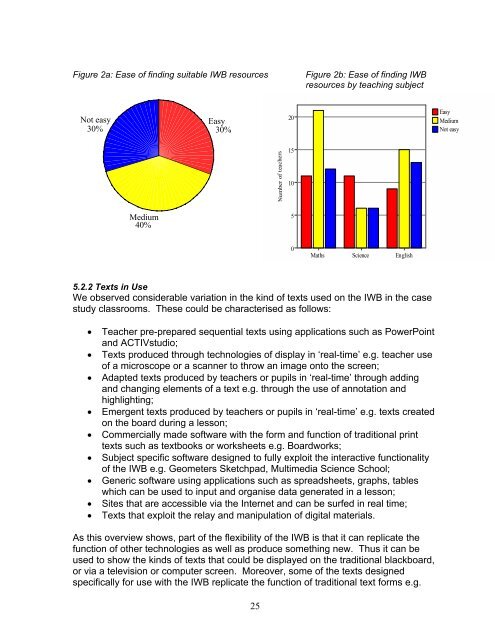The Interactive Whiteboards, Pedagogy and Pupil Performance ...
The Interactive Whiteboards, Pedagogy and Pupil Performance ...
The Interactive Whiteboards, Pedagogy and Pupil Performance ...
Create successful ePaper yourself
Turn your PDF publications into a flip-book with our unique Google optimized e-Paper software.
Figure 2a: Ease of finding suitable IWB resources<br />
Figure 2b: Ease of finding IWB<br />
resources by teaching subject<br />
Not easy<br />
30%<br />
Easy<br />
30%<br />
20<br />
Easy<br />
Medium<br />
Not easy<br />
15<br />
Number of teachers<br />
10<br />
Medium<br />
40%<br />
5<br />
0<br />
Maths Science English<br />
5.2.2 Texts in Use<br />
We observed considerable variation in the kind of texts used on the IWB in the case<br />
study classrooms. <strong>The</strong>se could be characterised as follows:<br />
• Teacher pre-prepared sequential texts using applications such as PowerPoint<br />
<strong>and</strong> ACTIVstudio;<br />
• Texts produced through technologies of display in ‘real-time’ e.g. teacher use<br />
of a microscope or a scanner to throw an image onto the screen;<br />
• Adapted texts produced by teachers or pupils in ‘real-time’ through adding<br />
<strong>and</strong> changing elements of a text e.g. through the use of annotation <strong>and</strong><br />
highlighting;<br />
• Emergent texts produced by teachers or pupils in ‘real-time’ e.g. texts created<br />
on the board during a lesson;<br />
• Commercially made software with the form <strong>and</strong> function of traditional print<br />
texts such as textbooks or worksheets e.g. Boardworks;<br />
• Subject specific software designed to fully exploit the interactive functionality<br />
of the IWB e.g. Geometers Sketchpad, Multimedia Science School;<br />
• Generic software using applications such as spreadsheets, graphs, tables<br />
which can be used to input <strong>and</strong> organise data generated in a lesson;<br />
• Sites that are accessible via the Internet <strong>and</strong> can be surfed in real time;<br />
• Texts that exploit the relay <strong>and</strong> manipulation of digital materials.<br />
As this overview shows, part of the flexibility of the IWB is that it can replicate the<br />
function of other technologies as well as produce something new. Thus it can be<br />
used to show the kinds of texts that could be displayed on the traditional blackboard,<br />
or via a television or computer screen. Moreover, some of the texts designed<br />
specifically for use with the IWB replicate the function of traditional text forms e.g.<br />
25

















